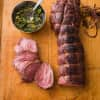Slicing Against the Grain: What It Means and How to Do It
Tenderize tough meat correctly on the first try.
If you look closely at a piece of beef, you'll notice little lines—bundles of closely packed muscle fibers that run parallel to one another. This pattern of fibers is referred to as the “grain” because it looks similar to the grain on a piece of wood.
When recipes call for slicing meat against (or across) the grain, it means you slice it perpendicular to the fibers instead of parallel to them. If you think of the fibers as a handful of dry spaghetti, you want to cut the bundle of spaghetti into shorter sections.
This is important because shorter lengths of muscle fibers are easier to chew. Luxe cuts such as rib eye or tenderloin are tender no matter how you slice them, but for tougher cuts such as flank steak or skirt steak, cutting against the grain is important to ensure pleasant eating.
To cut against the grain, look for the lines of muscle fibers and orient them so they run north to south on your cutting board. Then, slice east to west, perpendicular to the grain line. Sometimes that means making long cuts across a large piece of meat, such as a long skirt steak. To make slicing more manageable, we recommend first cutting the meat with the grain into smaller sections and then rotating the meat accordingly and proceeding to slice against the grain of the smaller sections.
The bottom line: Slicing against the grain means slicing across the muscle fibers, which makes otherwise tough meat more tender. Tender cuts do not need to be sliced against the grain.



